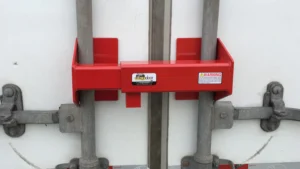Security is as important as size and delivery. A container that’s not locked properly is vulnerable to break-ins or tampering. That’s why we created a short Container 101 video showing how to lock a shipping container right. Watch it first, then follow the steps below to secure your unit.
In this article, you’ll learn:
-
Types of locks and where to install them
-
How to reinforce locking areas
- How are containers are built for security
- Common mistakes to avoid
🛠 Common Locking Methods for Containers
If you’re wondering how to lock a shipping container securely, it starts with understanding the types of locks that actually work.

- Heavy Duty Cargo Lock– built to secure containers by locking the innermost vertical locking bars together. This durable lock is easy to install and requires no mounting. Most secure option (Made with hardened steel and built with 2″ and 2 1/2″ square tube steel with 3/16″ thick walls. Weighs 13lbs.)
- Cargo Lock — Covers the doors with metal bars also securing by locking the innermost vertical locking bars together. Similar to the Heavy Duty Cargo lock, but not as heavy and thick (made with hardened steel. Weights 8lbs)
- Puck locks / disk locks — compact, hard to cut, but least secure option of all locks. Not sold or rented by Rent-A-Container.
Each option has pros and cons depending on usage, location, and threat level.
🔧 How to Lock It Right (Step-by-Step Guide)
Below is a practical sequence (adapt or match to what’s in your video) to secure a container effectively:
-
Align and close the doors fully so they meet flush
-
Check and clean door seals or rubber gaskets so the lock sits tight
-
Install primary lock (optional) (e.g. combination or padlock) into the locking point
-
Add secondary reinforcement (like cargo lock and heavy duty cargo lock) if your application needs added security
-
Ensure no gaps or pry points exist around the lock area
-
Test the locking mechanism by gently pulling or nudging the door to confirm it won’t open
🧱 Reinforced for Security: How Our Containers Support Strong Locks
We know that a lock is only as secure as the container it’s installed on. That’s why every Rent-A-Container unit is built with reinforced security features that help your lock do its job—and protect your gear.
Here’s what we include to help you secure your container:
-
Reinforced lock housings made from hardened steel to resist cutting and drilling
-
Solid steel doors and framing—no thin panels or weak points around the locking zone
- Secure rubber seal around container doors
We build our containers with security in mind from the start, so your lock isn’t doing all the work alone.
⚠️ Mistakes to Avoid When Locking a Shipping Container
-
Locking before the doors are fully aligned (can jam door and damage lock)
-
Relying on one lock in high-risk areas
-
Using cheap or low-quality locks
-
Neglecting to maintain the lock (rust, debris, loose bolts)
-
Losing track of keys for your locks
Review your container’s lock zone regularly and re-tighten or replace hardware as needed.
🎯 Why Proper Locking Matters
You invest in containers to secure inventory, tools, or systems. A locked but poorly secured container is a liability. A well-locked container:
-
Deters theft
-
Protects against forced entry
-
Reinforces your professional operation
-
Reduces insurance risk and loss
✅ Final Thoughts & Next Steps
A robust lock setup can greatly increase the safety of your container. Watch the video above, apply the steps, and let your container work for you without worry.
Want help picking or installing the right lock for your container? Contact Rent‑A‑Container and we’ll steer you to the best lock options and installation guidance.
(Bonus) For help organizing the space inside after you’ve locked it down, check out Eagle Leasing’s guide: How to Organize a Storage Container Like a Pro.
